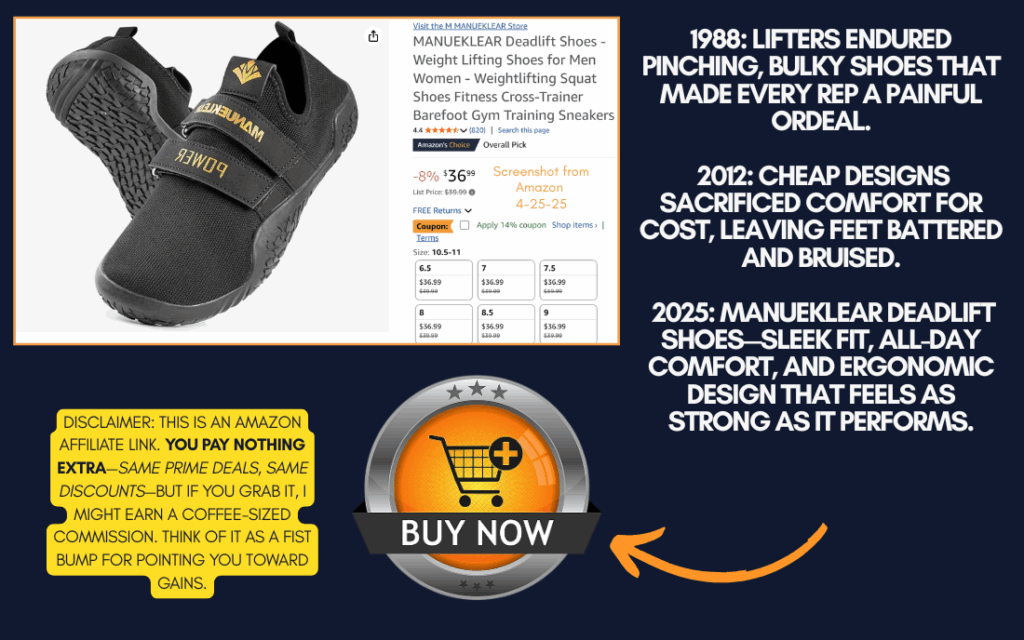Let’s cut to the chase: If you’ve ever felt your feet slip, your heels wobble, or your power leak into the floor during a heavy deadlift, you’re not alone. MANUEKLEAR Deadlift Shoes are designed to solve those exact problems. But here’s the kicker: they’re not for everyone. This isn’t about convincing you. It’s about answering one raw, practical question: Do these shoes actually matter? Let’s dissect the science, the sweat, and the skepticism.
The Anatomy of a Deadlift Shoe: What Makes Them Different?
Deadlift shoes are flat, thin-soled, and minimalistic, engineered to mimic the stability of lifting barefoot—but with a grip that won’t quit. Unlike squishy running shoes or raised-heel weightlifting kicks (like the Nike Romaleos 4s), deadlift-specific shoes have two non-negotiable features:
- Zero heel-to-toe drop: The sole is dead flat—no 20-millimeter lifts here.
- Ultra-thin soles (2-5mm): Lets you “feel” the floor, driving power through your midfoot.
“The closer your foot is to the ground, the more force you can generate,” says Eugene Thong, CSCS. “It’s physics—less energy lost, more transferred straight into the bar.”
Who Should Buy Deadlift Shoes (And Who Should Skip Them)
✅ FOR:
- Lifters chasing 1RMs or competing in powerlifting.
- Anyone with ankle mobility issues (flat shoes reduce knee shear).
- Folks who hate deadlifting in socks but want that “barefoot” feel.
- Your gym bag if: You’re tired of swapping between squishy cross-trainers and lifting shoes.
🚫 NOT FOR:
- Casual gym-goers who bench more than they deadlift.
- Fans of cushioned soles or arch support.
- People who need a shoe for everything (these are specialized tools).

MANUEKLEAR Deadlift Shoes: The Brutally Honest Pros & Cons
| Pros | Cons |
|---|---|
| 2mm TPU sole for max ground connection | Not ideal for running or HIIT |
| Reinforced midfoot straps for lockdown | Minimal arch support (bye-bye, weak feet) |
| Durable enough for 500lb+ pulls | Aesthetics split crowds (no neon flashes) |
“Deadlift shoes are like a wrench,” says Charles Damiano, B.S. Clinical Nutrition. “They do one job extremely well—everything else, not so much.”
Deadlift Shoes vs. The World: How They Stack Up
- Nike Romaleos 4s: Raised heel (20mm) great for squats, but deadlifts? You’re fighting gravity.
- Sabos: Similar to MANUEKLEAR, but with a 15mm sole—thicker, less “barefoot.”
- Barefoot/Minimalist Shoes: Close, but lack the gritty traction and toe protection.
The winner for deadlifts? Specialized shoes. For squats, bench, or daily wear? Grab something else.
The Science of Stability: Why “Feeling the Floor” Matters
When you deadlift, power starts at your feet. A thin, rigid sole (like MANUEKLEAR’s 2mm TPU) lets your foot muscles engage fully, creating a “rooted” sensation. Raised heels or soft soles force your body to compensate, leaking power into stabilization. It’s the difference between pushing a car barefoot vs. in marshmallow sandals.

“Should I Just Deadlift in Socks?”
Sure—if your gym allows it. But socks lack grip, toe protection, and hygiene points. Deadlift shoes add a gritty, no-slip layer while keeping your toes safe from rogue weight drops.
The Final Verdict
If you’re serious about deadlifts, these shoes are worth it. They’re not a magic bullet, but they are a precision tool. For the casual lifter? Stick with your Chucks or barefoot vibes.
🔥 GRAB THE MANUEKLEAR DEADLIFT SHOES HERE → Heads up: These link is an Amazon affiliate link. You drop zero extra cash, still get the best deals, and we get a tiny kickback. That’s capitalism with creatine.
Parting Wisdom
Deadlift shoes won’t fix your form or replace consistency. But if you’re chasing pounds, PRs, or that sweet click of a perfectly locked pull, they’re the unsung hero your lifts deserve. Or, as one seasoned lifter growled mid-set: “These aren’t shoes—they’re forklifts for your feet.”
Bottom line: Specialized tools for specialized jobs. Choose wisely. Lift brutally.
YOUR NEXT STEPS:
